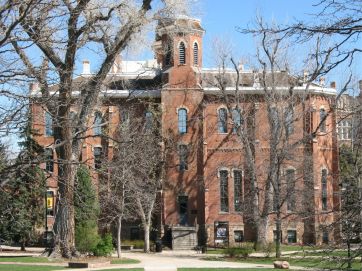The Innovative University: Changing the DNA of Higher Education from the Inside Out, by Clayton M. Christensen and Henry J. Eyring, $32.95, Jossey-Bass, 475 pages.
A Review by Peter Wood
Online college courses are a “disruptive technology” destined to drive profound changes in higher education in the United States and around the world. This is not an especially new idea. Management guru Peter Drucker, for example, declared in 1997, in an interview with Forbes: “Thirty years from now the big university campuses will be relics. [...] The college won’t survive as a residential institution.” And a great many others—some enthusiastic, others mournful—have since made similar pronouncements.
The term “disruptive technology,” however, is a bit of a novelty. It comes from the co-author of The Innovative University, Clayton M. Christensen, a professor of business administration at Harvard Business School, best known for his 1997 book, The Innovator's Dilemma: When New Technologies Cause Great Firms to Fail. That book might best be thought of as elaborating Joseph Schumpeter’s idea of the “creative destruction” characteristic of capitalist economies. (Schumpeter, in turn, was appropriating and revising an idea framed by Karl Marx.) For Schumpeter, writing in the 1940s, “creative destruction” was mainly a matter of new technologies pushing aside old ones: an essential characteristic of free markets. Christensen added up-to-date examples and some vivid characterizations of how disruption unfolds.
The Innovative University can be read at one level as an attempt by Christensen and his co-author Henry Eyring to fit higher education to Christensen’s template of technological change. The book, however, doesn’t stop there. It is a sprawling army of topics and themes and metaphors. Besides the idea that online learning is the disruptive technology that will transform higher education, Christensen and Eyring are intent on (1) reprising the whole history of Harvard University, (2) narrating the rise of Brigham Young University Idaho from its extremely humble beginning in 1888 as a Mormon elementary school and later as the two-year Ricks College; and (3) detailing the administrative challenges in turning Ricks College into a hybrid residential-online powerhouse, (4) explaining and decrying the 1967 Carnegie Classification of colleges and universities, which fed the appetite of many institutions to move from modest teaching missions to become research-oriented, doctoral degree-granting universities.
Woven through all this are conspicuous threads of pride in the contributions of Harvard Business School faculty members, approbation for the wisdom of Mormon elders, accolades for various establishment figures in American higher education, such as Derek Bok and Gordon Gee, and tedious quotations from Hermann Hesse’s The Glass Bead Game.
When Good Metaphors Go Bad
And the book fairly groans under the weight of the ill-chosen metaphor of the subtitle, “Changing the DNA of Higher Education from the Inside Out.” This rhetorical atrocity might have been forgiven if it had been imposed by a slapdash editor, but no. Christensen and Eyring recur to it well more than one hundred times and try—vainly— to wring sense out of nonsense.
Let me make a small contribution to the cause of reforming the exposition of reformist ideas. DNA, the biological molecule, is not a felicitous metaphor for those long-standing ideals and practices of a university that a reform movement might seek to change. That’s because the DNA of an organism cannot be changed in any constructive way. It can degrade through exposure to radiation or cigarette smoke or sunburn; the body’s repair system can break down. Changes in an organism’s DNA generally point to aging, disease, and death. “Changing the DNA of Higher Education,” in other words, doesn’t sound like something to wish for.
Colleges and universities, like all institutions, do indeed have characteristic ways of doing things. The old-fashioned vocabulary for pointing this out was to say that they have customs and traditions. Since we belong to an age in which lots of people (falsely) assume that customs and traditions lie as lightly on us as Tommy Bahama bed sheets on a hot summer night, we have taken to calling the stubbornly persistent aspects of an institution, its “culture.” (If we want to climb still higher on the ladder of intellectual pretension, we can drop in the word popularized by Pierre Bourdieu, “habitus.”) The idea is broadly the same. People in an institutional context tend, over time, to do things in a certain way. The mere act of repetition gives to customs a warrant. If it ain’t broke don’t fix it. And if our social betters are doing it, maybe we should too.
An advantage of calling customs “customs,” traditions, or culture is that such words point at the possibility of change. Customs often prove weightier than bed sheets, but they aren’t caskets. We can climb out if we really want to.
When Christensen and Eyring alighted on “DNA” as a way of talking about enduring institutional identity—e.g. “Harvard’s DNA,” “Ricks College’s DNA”—they found a seemingly handy way to emphasize that institutional identities can be very stable over the long term. DNA is a good metaphor if your aim is to emphasize that things don’t change at all from generation to generation. The metaphor is also a serviceable way to acknowledge that institutions have a built-in tendency to reproduce themselves.
But Christensen and Eyring have written a book announcing a new dawn and urging American higher education to hasten to meet it. Hence that subtitle: “Changing the DNA of Higher Education from the Inside Out.” Each time I read it, I picture a bunch of lab-coated education reformers, Craig Venter-like, extracting DNA from a struggling college strapped to a gurney. One of them, looking a good bit like John Carradine, says, “Struggle all you want little college. We will snip the telomeres from your DNA, rearrange its nucleobases, and make you brand new from the inside out!”
Why grouse about a mere metaphor? Because the darn thing shows up every time Christensen and Eyring try to say anything important; because little line drawings of DNA molecules festoon more than fifty pages of the book, never letting the reader forget we are in the realm of maladroit writers; and because the authors insist on this image as a key to their argument.
Genteel Disruption
That said, the argument itself isn’t bad, and The Innovative University may be an important book. That’s because it gives a new seal of high authority to the long-bruited idea that online education is about to sweep away many colleges and universities and radically transform the rest. The idea, as I said, is not new. But it gains considerable power coming from a Harvard Business School professor addressing the public in a “big” book. What has been until now the argument of pioneers and visionaries—figures such as Richard Bishirjian, George Leef, and Richard Vedder—has been taken up and recast as the up-to-date insights of Cambridge-based managers.
Christensen and Eyring, moreover, go out of their way to show their mainstream sensibilities. Hack administrators are praised to the skies. Higher education’s bien pensant apologists have new medals pinned to their hollow chests. Academic touchstones are rubbed reverently until they positively glow. Consider this brief summary of the achievements of Derek Bok:
On the second front, gender and racial diversity, Harvard made as much progress in Bok’s two decades in office as it had in his predecessors’ combined century of oversight. The university’s soaring prestige produced larger applicant pools, allowing Harvard to recruit minority and female professors and students without lowering standards of merit. (p. 173)
Anyone eager to scout the substance of this 400-page book has to be prepared to wade through quite a bit of this effluent along the way.
But what of that substance? The argument goes something like this. “Disruptive technologies” typically emerge at the low end of the market. Big established companies focus on making incremental improvements in the technology they have already mastered. The products they make are targeted ever more to the affluent end of the market that can be enticed by the prospect of upgrades. By focusing on that end of the market, these industry giants neglect potential consumers who can’t afford the luxury versions of the goods. These “disenfranchised” would-be consumers are ripe for the picking if someone can find a cheap new way to serve them. The new substitute good need not initially be very good. It has to do only a little of what the expensive alternative does.
But that’s just the prelude. According to Christensen’s theory, this new technology becomes “disruptive” when the new companies that make it begin rapidly to improve it. Soon they reach the point where they can compete head-to-head with the old established companies. Vacuum tube hi-fis get brushed aside by transistor radios. Detroit loses major market share to Asian car makers. The microcomputers once made by DEC and Wang disappear as personal computers became better and better.
Christensen also has had a lot to say about why the old established companies so often fail to catch up with the newer technology once it has become clear that the times are changing. A few of these companies do adapt, but mostly their efforts to change their ways are too little and too late. The fresh competitors typically have the know-how and experience with the new technology and they do not carry the burden of also trying to serve the legacy customers of the old technology. They aren’t stuck with obsolete plants and equipment or deeply embedded but no longer functional ways of doing business.
This is, on its face, a pretty convincing picture of how Schumpeterian “creative destruction” really unfolds. How well does it apply to higher education?
Why Colleges Are Vulnerable: The Technological Explanation
The real answer is that nobody knows. Christensen and Eyring are making a strong prediction. I happen to be among those who think they are basically right, but I arrive at that conclusion from a somewhat different path and it may be useful to explain the difference.
Christensen and Eyring’s analysis has so many moving parts that it is hard to summarize, but the main components are:
- Online course technology has reached the point of sophistication at which it is generally comparable, and in certain respects superior, to classroom instruction in quality. “Online courses are demonstrably better, not equaling or exceeding the cognitive outcomes of classroom instruction.” (p. 212)
- Online colleges have big advantages in the economics of higher education. The biggest component cost of college is payroll. The online institutions “enjoy easy access to a growing body of skilled instructors who know how to make the most of the medium,” and who can be paid peanuts because:
- “[T]raditional universities’ overproduction of master’s and Ph.D. degree holders relative to their own needs has created a pool of qualified online instructors who are willing to work for a few thousand dollars per course.” (p. 213)
- The online institutions staff courses on a piecework basis. “Online instructors are paid by the course.” If a course doesn’t fill up, it isn’t taught and no one gets paid.
- Underperforming faculty members are dispatched. No tenure.
- Traditional higher education has become unsupportably expensive. It will have to cut costs, and there are only two real avenues for doing so:
- “Increase the percentage of students who graduate” on time.
- “Decrease the costs of institutional resources that go into it, especially the costs of facilities and instruction.” And, “the most powerful mechanism of cost reduction is online learning.” (p. 338)
- “The number of students worldwide seeking education is growing,” (p. 344) but the current residential system of colleges and universities is incapable of meeting this demand.
- Online education is organized to meet the needs of students rather than serve the interests of faculty members.
- The traditional research university (and the many colleges and universities that aspire to that status or are influenced by the model) have to balance teaching with “discovery research.” Teaching generally suffers as a result. And as it happens, “discovery research” also suffers. It can be done better elsewhere. “Employees of purely discovery-focused corporate R&D groups and government research institutes are inherently more cost effective than university scholars, who must split their time between research and instruction and whose explorations are not market driven.” (p. 350)
These are good observations and indeed point in the direction of online education as a “disruptive technology” that is likely to undercut traditional models of higher education. But there is at least one other way to assess the rise of online education: it is gaining power at the expense of traditional colleges and universities because of what I call “cultural defection.”
Cultural Defection
What I mean by “cultural defection” is the rejection of what have been long-standing assumptions about goals and pathways in favor of new approaches. Some kinds of cultural change are gradual and often below the threshold of what people notice; but sometimes cultural shifts are abrupt. A hitherto conforming segment of the population suddenly finds its voice, and often to the consternation of the guardians of the established ways, sets off in a brand new direction. The most recent example is the spontaneous organization of the Tea Party, following Rick Santelli’s outburst on CNBC, February 19, 2009. After the fact, of course, analysts identified numerous libertarian and conservative precursors to the movement, but the movement itself crystallized quite suddenly. It could do so because a substantial body of people had become quietly disaffected from the prevailing political culture and lacked only the opportunity to see themselves as a part of a larger whole.
Cultural defections are not necessarily left or right in political orientation, or even necessarily political at all. They occur when those who are alienated from a normative institution discover a viable alternative. The big band era gives way to rock ‘n roll. Or, since Christensen and Eyring have put the Mormon Church into the picture, Joseph Smith attracts a following in New York’s “burnt-over district” and leads his flock to Nauvoo, Illinois. Abrupt, seemingly spontaneous change is actually not all that rare, though it is rare enough that it still registers as something seismic.
American higher education has been ripe for cultural defection for quite some time. It hasn’t happened because such defection needs to crystallize around a viable alternative and until now, none has appeared. But Christensen’s “disruptive technology” of sophisticated online instruction is now providing the missing element.
Why should a substantial number of Americans be ripe for cultural defection from “the world’s best educational system?” As this is a review written for Minding the Campus, I needn’t provide too much elaboration. The key points are these:
- Many Americans sense that our colleges and universities embody and convey to students a low regard for our civilization. The prevailing spirit of our system of higher education is antagonistic to our nation and our culture. It is also antagonistic to traditional religious views. Nor is it always a passive antagonism. Colleges and universities provide numerous, almost daily instances of a privileged elite sneering at the beliefs and values of the general population. If this isn’t an invitation to cultural defection, what is?
- Colleges and universities have positioned themselves as the gateway to material success in American life. The college degree has become, at least in the minds of many, the indispensable prerequisite for a career. This puts those who are alienated from the cultural antagonism embodied in higher education in a bind. Much as they resent the institution, they must accede to it in order to obtain a college degree (for themselves or their children). The gateway problem has been exacerbated by the barriers that higher education has put in the way of the creation of new colleges and universities. All of this intensifies the underlying cultural defection.
- Americans increasingly recognize that college degrees have been oversold. The prices are too high relative to the benefits. (Though establishment figures vehemently disagree, millions of Americans have drawn their own conclusions.) To obtain a college degree, many students go deeply into debt, and a large portion of these debtors find it very difficult to dig their way out. They find the market value of the credential is much less than they had believed. Nevertheless, the major voices of the education establishment insist ever more urgently that the pursuit of a college degree is a “good investment” for the individual and that our “national competitiveness” depends on sending a substantially greater percentage of young people to college. The establishment’s answer to a gross oversupply of college graduates is to seek to double that supply. This too is a source of the public’s deep distrust of the cultural elites who defend our current system of higher education.
American higher education marketed itself for the last fifty years or so as primarily a utilitarian good. Getting a college degree was sold less as a matter of getting a good education than as a matter of getting a valuable credential. The magnification of college credentials proved to be an excellent way to drive the expansion of colleges and universities—ballooning their enrollments as well as their faculties and administrations. The rise of the mass university, however, also brought the vulnerabilities that Christensen and Eyring help bring into focus.
I don’t disagree with their “disruptive technology” thesis; but I do think it needs to be considered in light of the cultural defection that gives it a context. If America’s residential colleges and universities are about to face major competition from online programs, that will be because there is a pent-up readiness among many Americans to embrace an alternative.
How Can Traditional Colleges Adapt?
Christensen and Eyring’s “disruptive technology” thesis and my “cultural defection” thesis both arrive at the conclusion that online education will pose a major challenge to the existing system of residential colleges and universities. But beyond that, the theses point in some different directions. Christensen and Eyring end up arguing (Chapter 23, “New DNA”) that the old guard colleges and universities can happily escape the fate of other obsolete industries. They can make some painful tradeoffs and emerge as one of several kinds of new institution. “Regional universities” can downsize, consolidate, and get a lot more “vocational.” They can shed “discovery research” and focus on demonstrating “learning outcomes.” “Elite liberal arts colleges” should become more “student-oriented” but can otherwise expect to ride out the transition. “Less well-endowed private colleges” will have to redesign themselves as hybrid residential/online programs with fewer full-time faculty members and lots more adjuncts.
Christensen and Eyring hold that “what universities do best” is discovery of new knowledge, the intellectual grounding of students (“memory”), and mentorship. These, along with the sunk investment in facilities and space mean, according to their reckoning, that the traditional sector of higher education will survive—with modifications. They are “cautiously optimistic,” and conclude that “the world desperately needs its university communities,” which are “best positioned to integrate new discoveries with the wisdom of the past and to show how those discoveries can improve current practice.” (p. 399)
This sounds to me less like “cautious optimism” than doxology. Indeed at one point in the book they cite with approval Jonathan Cole’s heap of burning incense, The Great American University, as testifying to “university discoveries [that] have helped shape the modern world.”
Be that as it may, if the cultural defection thesis is accurate, the fate of many colleges and universities may be swifter and darker than Christensen and Eyring predict. It is not clear to me that students who remain in sympathy with the cultural outlook of our existing colleges and universities, along with foreign students who can be recruited to residential colleges in the U.S., will make up for the large number of students who will soon be departing for online alternatives.
These students have no sentimental attachment to the old universities. They will feel the lure of lower costs and greater convenience along with the relief that they won’t have to put up with the ideological nonsense of traditional higher education. I also expect that the online programs will in short order do away with the “gender gap,” which has made American undergraduate enrollment nearly 60 percent female.
I do think that Christensen and Eyring are right that traditional colleges and universities will put up a good fight in the form of trying to integrate online programs with their residential base. Most are already engaged to some degree in this venture; and some will surely succeed in finding the right mix. But I suspect most won’t, and that will bring into play one of the few factors that Christensen and Eyring don’t explore: whether the public that finances public colleges and universities and underwrites the nation’s student grant and loan programs, will continue to subsidize American higher education at current levels if students begin to take themselves to newer, lower-cost alternatives.
Reform by Fiat
This is an open question. Higher education has powerful lobbies and the good will of numerous elected officials. On the other hand, the nation faces deep deficits and the need to cut spending, and we could conceivably achieve educational results better than we have now at a fraction of the cost. So the topic is bound to become part of our political debate in the years ahead.
I’ve said all this without ever getting around to Christensen and Eyring’s absorbing account of the history of Harvard University, their richly detailed chronicle of Ricks College, and their finely-pointed analysis of how Ricks became Brigham Young University Idaho. It is possible the reader will find a little more detail in all these than is entirely needed. I applauded the BYU Idaho’s sudden death elimination of all its intercollegiate athletic programs via a video conference call from 90-year-old church president Gordon Hinckley, June 30, 2000. Mr. Hinckley also took the occasion to turn the two-year college into a four-year college, change its name, put it on a year-round academic schedule, re-center it on online technology, declare that “faculty rank will not be part of the academic structure,” and scale up the college to “serve more students.”
This makes for fascinating reading, though not so fascinating that I really wanted to know which committees headed by which faculty members took the lead in developing which new modular programs. But in case you are in the position to commandeer a whole college and arrange it to your liking, and the BYU Idaho model appeals, it may be helpful to have the minutia.
The BYU Idaho provides what amounts to a Harvard Business School case study. As with any case study, one can wonder how well the narrative can transfer to other instances. The role of the Mormon Church in this case propels some doubt. There are few colleges in the United States so effectively under the control of a single institutional authority that they could be changed so utterly. In most of higher education, “shared governance,” weak boards of trustees, and the power of various “stakeholders” would combine to stop such a thing in its tracks.
But that it has happened even once is remarkable and worth knowing about. But even Mr. Hinckley can’t change DNA. Fortunately he didn’t have to.
This review originally appeared in Minding the Campus on August 16, 2011.













